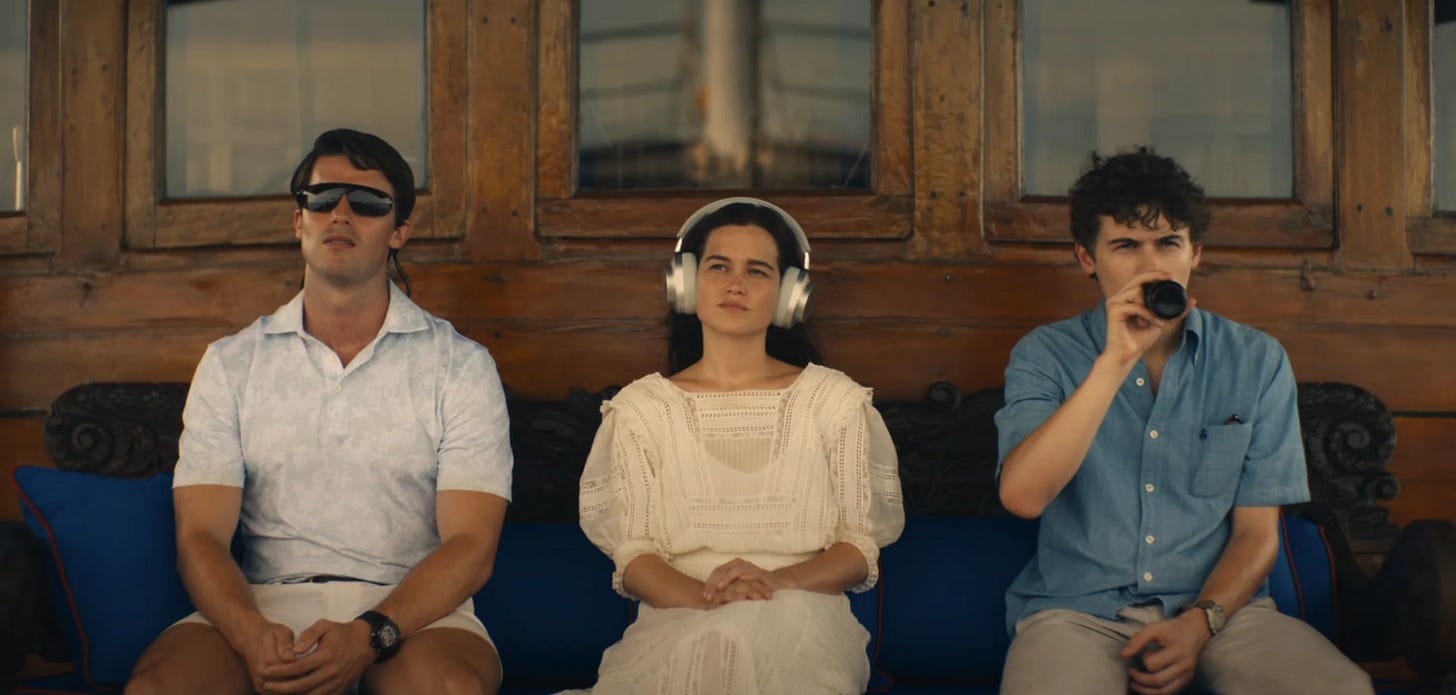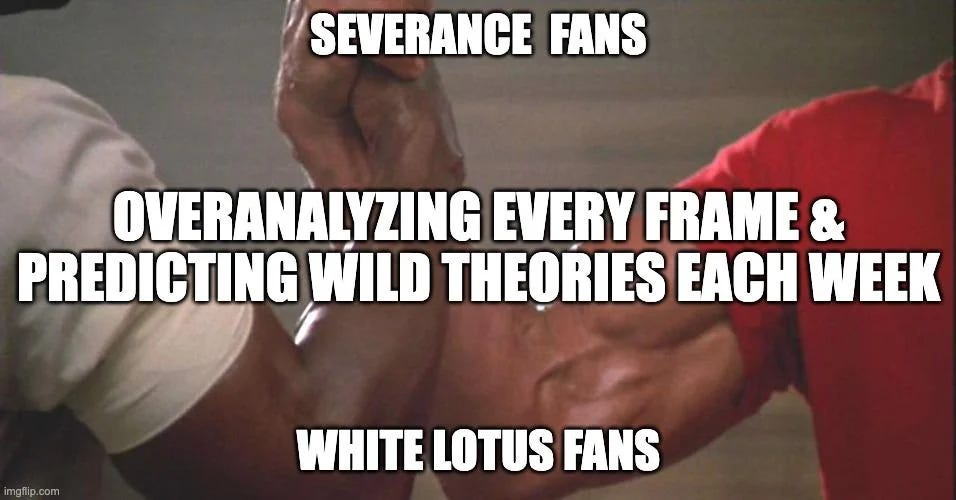Has Fan Theory Replaced Plot? 'The White Lotus,' 'Severance' and the Conspiracy Economy
is the writers room in the room with us?
Is it just me or are our favourite television shows of the moment running low on plot?
For the past few weeks, I have spent Sundays anticipating The White Lotus, only to finish the episode wondering what — if anything — actually happened. The show’s iconic opening theme music, once a melody of entrancing, yodeling howls, is gone, and, vanishing with it, is the propulsive plot.
For its third season, Mike White's beloved class satire takes its audience to Thailand. In familiar whodunit fashion, the show begins with an unidentified murder at a luxury hotel, the titular White Lotus, and then transports the audience back to the events that preceded it. Because of this structure, akin to an Agatha Christie murder mystery, its inciting hook can be more accurately described as a question mark: What the hell happened here?
However, too many of the tenets that once captivated audiences are repeated in this new season. The episodes are ripe with White’s hallmark characterizations: the chauvinistic man-Karen of Saxon, the do-good-but-lowkey-bad-at-their-job, earnest-to-a-fault hotel employee of Gaitok, and the aloof, wealthy white lady du jour of Parker Posey. (No viewer on the planet is actually calling her by her character’s name, Victoria). As entertaining as these archetypes are, they have begun to feel trite in the show’s third season. So much so, that White doesn’t go to great lengths to develop them, relying on our recall of previous seasons where we enjoyed similar archetypes with better-defined character arcs. We’ve met them all before: Paxon in Shane/Cameron, Gaitok in Armand/Valentina, and Parker Posey in Jennifer Coolidge. But in their previous iterations, they did something we seldom see their current incarnations do; they moved the plot.
The plot development we’ve grown accustomed to is replaced with lethargic scenes, steeped with gestures but shy on the action, that are braided into other scenes that fill the episode. This technique, which hopscotches scenes across others rather than giving us one contained scene, makes the episode feel fuller than it actually is. It’s a meandering edging that never takes you to climax. The tension builds but ultimately leads to nothing. You’re left hungry for more. Or worse, with no recollection of what you were served.
We get Survivor-inspired shots of monkeys scratching their asses and beached blowfish on the shores of the resort. We are fed extended vignettes of Mook (BLACKPINK’s Lisa) dancing, randomly cut across other scenes to build the ‘vibe.’ At times, this foliage is successful. Much can be derived from art’s intangibility, motifs that supersede the more direct elements of craft, like plot and character. You can build a compelling novel on plotless, ‘vibey’ fiction; a film can skate by on cinematography and style. A generous reading of White’s flat characters and lingering imagery is that they act more as symbols rather than products of realism, and thread the show’s themes of identity construction, spiritual rot, and class. But when episodes have become overwrought with these bloated interstitials, their output feels closer to a perfume ad than a prestige prime-time drama.
The elements that drive tension are legible: hammed-up performances by an underutilized cast, and dramatic music to nudge you to pay attention. But it all leads to a cliff. You feel like you should be reacting more, and experience a deflation when you don’t. When I watched Succession and Industry, other HBO Sunday slot series, I felt like I couldn’t take a bathroom break or check my phone without missing something. Now, with The White Lotus, I take a leak at leisure, knowing I won’t miss much.
To me, it feels like Mike White filmed for six episodes this season, only for HBO to catch him off guard with a request to stretch it to eight in the post-production, causing him to dilute the punch of the plot across more episodes. This, of course, isn’t confirmed; it’s just my inkling, but it should be mentioned that The White Lotus episode count has steadily climbed over the years. Season 1 had six episodes, while Season 2 had seven. This latest season, where the pacing is most compromised, will be its longest.
Despite this, the season feels more relevant than ever. The cast has stepped into an aggressive promotional campaign, fueled by apparel ads, controversial talk show appearances, nepo baby allegations, and magazine spreads.
Above all, what has really prevailed are the fan theories. Across Reddit, across TikTok. Across my group chat, and my work calls. Everyone has an opinion about what we are about to see. An answer to the inciting question of “What the hell happened here?” And instead of being presented with a plot, we’ve filled in our own.
Severance, another favourite of mine, is also bolstered by the conspiracy economy. While The White Lotus’s buzz is catalyzed by a vacancy of plot, Severence’s response is driven by perhaps too much of it. The world of Severance, a dystopian office thriller by Ben Stiller, is equipped with so much lore and backstory that you practically need to do supplemental research to understand what is going on.
In addition to the studied breakdowns found across podcasts and TikTok, there is also an official book issued by AppleTV, authored by one of the characters for additional context. The world of the show is so rich that it almost relies on its fan apparatus to drive comprehension. Severance is perfect for nerds who thrive on being the one who can extract conclusions from confusion. In this sense, it’s a show that could only exist in the new era of streaming, as its understanding is predicated on your ability to hit pause.
What’s remarkable is that although Severence’s episodes are full of development, most of their consequences seem unrelated. Some exist as flashbacks, others exist as bottle episodes. This season felt more fragmented and less bound by chronology than the first. There is a structure, yes. But it relies on its audience being patient enough to track against it.
The conversation surrounding these shows has become essential to their function and enjoyment. The episode is no longer the primary vehicle for the series. Instead, a television show’s experience is measured by how its narrative extends through social media feeds, merchandise, brand partnerships, surprise cameos, and subtitled screengrabs hosted on content creators' Instagrams. The conversation is akin to the online frenzy that used to saturate Twitter/X during the pre-streaming Shondaland days of Grey’s Anatomy and Scandal… but this feels like something else entirely.
Sometimes, a project's ideas are more compelling than the project itself. Perhaps the concept, its aesthetic, and the conversation surrounding it are too big for the project’s primary artifact, be it a book, an album, a show, or a movie. Other times, the idea is just more marketable than its individual parts and therefore, more easily scaled.
It’s not easy for me to remember exactly what happened in the latest episode of The White Lotus but it is easy for me to send a meme of Parker Posey nailing the line “I don’t even have my Lorazepam,” which, after you wade through its hilarity, is a sharp summating thesis for the show’s perspective on the short-term, transactional ideals of the privileged. But, perhaps, Mike White and HBO already know this. They’ve seen the stories you’ve shared online. Maybe it’s much easier – more lucrative – to create these bite-sized, shareable moments that stand in for the show than sustain audiences through weekly, episodic storytelling. I’d ask if the writers room is in the room with us, but the answer is an obvious yes. We have become a part of the writers room.
Keep reading with a 7-day free trial
Subscribe to LOOSEY to keep reading this post and get 7 days of free access to the full post archives.







